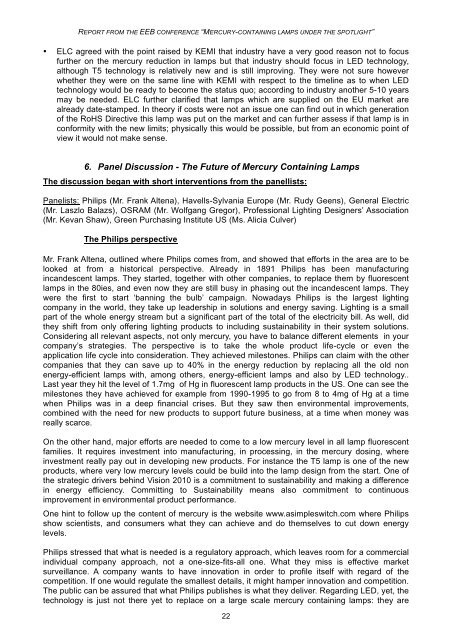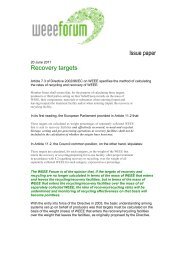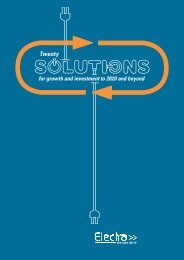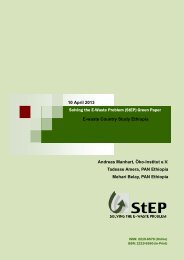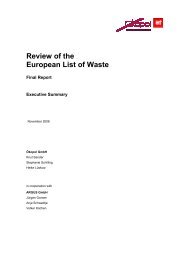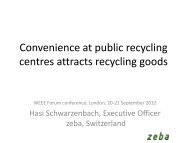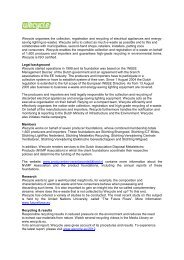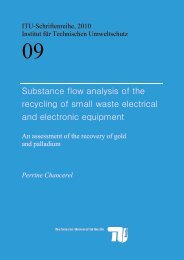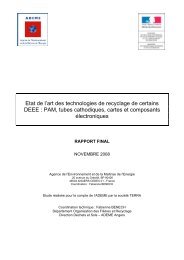Mercury containing lamps under the spotlight - WEEE Forum
Mercury containing lamps under the spotlight - WEEE Forum
Mercury containing lamps under the spotlight - WEEE Forum
Create successful ePaper yourself
Turn your PDF publications into a flip-book with our unique Google optimized e-Paper software.
REPORT FROM THE EEB CONFERENCE “MERCURY-CONTAINING LAMPS UNDER THE SPOTLIGHT”<br />
• ELC agreed with <strong>the</strong> point raised by KEMI that industry have a very good reason not to focus<br />
fur<strong>the</strong>r on <strong>the</strong> mercury reduction in <strong>lamps</strong> but that industry should focus in LED technology,<br />
although T5 technology is relatively new and is still improving. They were not sure however<br />
whe<strong>the</strong>r <strong>the</strong>y were on <strong>the</strong> same line with KEMI with respect to <strong>the</strong> timeline as to when LED<br />
technology would be ready to become <strong>the</strong> status quo; according to industry ano<strong>the</strong>r 5-10 years<br />
may be needed. ELC fur<strong>the</strong>r clarified that <strong>lamps</strong> which are supplied on <strong>the</strong> EU market are<br />
already date-stamped. In <strong>the</strong>ory if costs were not an issue one can find out in which generation<br />
of <strong>the</strong> RoHS Directive this lamp was put on <strong>the</strong> market and can fur<strong>the</strong>r assess if that lamp is in<br />
conformity with <strong>the</strong> new limits; physically this would be possible, but from an economic point of<br />
view it would not make sense.<br />
6. Panel Discussion - The Future of <strong>Mercury</strong> Containing Lamps<br />
The discussion began with short interventions from <strong>the</strong> panellists:<br />
Panelists: Philips (Mr. Frank Altena), Havells-Sylvania Europe (Mr. Rudy Geens), General Electric<br />
(Mr. Laszlo Balazs), OSRAM (Mr. Wolfgang Gregor), Professional Lighting Designers’ Association<br />
(Mr. Kevan Shaw), Green Purchasing Institute US (Ms. Alicia Culver)<br />
The Philips perspective<br />
Mr. Frank Altena, outlined where Philips comes from, and showed that efforts in <strong>the</strong> area are to be<br />
looked at from a historical perspective. Already in 1891 Philips has been manufacturing<br />
incandescent <strong>lamps</strong>. They started, toge<strong>the</strong>r with o<strong>the</strong>r companies, to replace <strong>the</strong>m by fluorescent<br />
<strong>lamps</strong> in <strong>the</strong> 80ies, and even now <strong>the</strong>y are still busy in phasing out <strong>the</strong> incandescent <strong>lamps</strong>. They<br />
were <strong>the</strong> first to start ‘banning <strong>the</strong> bulb’ campaign. Nowadays Philips is <strong>the</strong> largest lighting<br />
company in <strong>the</strong> world, <strong>the</strong>y take up leadership in solutions and energy saving. Lighting is a small<br />
part of <strong>the</strong> whole energy stream but a significant part of <strong>the</strong> total of <strong>the</strong> electricity bill. As well, did<br />
<strong>the</strong>y shift from only offering lighting products to including sustainability in <strong>the</strong>ir system solutions.<br />
Considering all relevant aspects, not only mercury, you have to balance different elements in your<br />
company’s strategies. The perspective is to take <strong>the</strong> whole product life-cycle or even <strong>the</strong><br />
application life cycle into consideration. They achieved milestones. Philips can claim with <strong>the</strong> o<strong>the</strong>r<br />
companies that <strong>the</strong>y can save up to 40% in <strong>the</strong> energy reduction by replacing all <strong>the</strong> old non<br />
energy-efficient <strong>lamps</strong> with, among o<strong>the</strong>rs, energy-efficient <strong>lamps</strong> and also by LED technology..<br />
Last year <strong>the</strong>y hit <strong>the</strong> level of 1.7mg of Hg in fluorescent lamp products in <strong>the</strong> US. One can see <strong>the</strong><br />
milestones <strong>the</strong>y have achieved for example from 1990-1995 to go from 8 to 4mg of Hg at a time<br />
when Philips was in a deep financial crises. But <strong>the</strong>y saw <strong>the</strong>n environmental improvements,<br />
combined with <strong>the</strong> need for new products to support future business, at a time when money was<br />
really scarce.<br />
On <strong>the</strong> o<strong>the</strong>r hand, major efforts are needed to come to a low mercury level in all lamp fluorescent<br />
families. It requires investment into manufacturing, in processing, in <strong>the</strong> mercury dosing, where<br />
investment really pay out in developing new products. For instance <strong>the</strong> T5 lamp is one of <strong>the</strong> new<br />
products, where very low mercury levels could be build into <strong>the</strong> lamp design from <strong>the</strong> start. One of<br />
<strong>the</strong> strategic drivers behind Vision 2010 is a commitment to sustainability and making a difference<br />
in energy efficiency. Committing to Sustainability means also commitment to continuous<br />
improvement in environmental product performance.<br />
One hint to follow up <strong>the</strong> content of mercury is <strong>the</strong> website www.asimpleswitch.com where Philips<br />
show scientists, and consumers what <strong>the</strong>y can achieve and do <strong>the</strong>mselves to cut down energy<br />
levels.<br />
Philips stressed that what is needed is a regulatory approach, which leaves room for a commercial<br />
individual company approach, not a one-size-fits-all one. What <strong>the</strong>y miss is effective market<br />
surveillance. A company wants to have innovation in order to profile itself with regard of <strong>the</strong><br />
competition. If one would regulate <strong>the</strong> smallest details, it might hamper innovation and competition.<br />
The public can be assured that what Philips publishes is what <strong>the</strong>y deliver. Regarding LED, yet, <strong>the</strong><br />
technology is just not <strong>the</strong>re yet to replace on a large scale mercury <strong>containing</strong> <strong>lamps</strong>: <strong>the</strong>y are<br />
22


